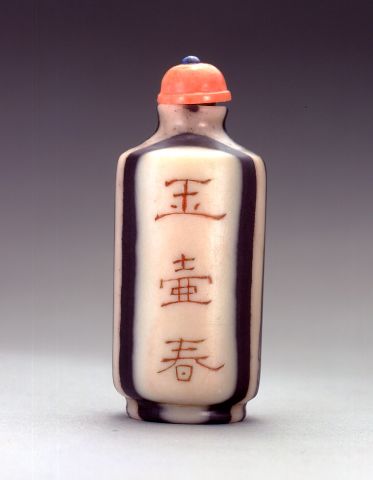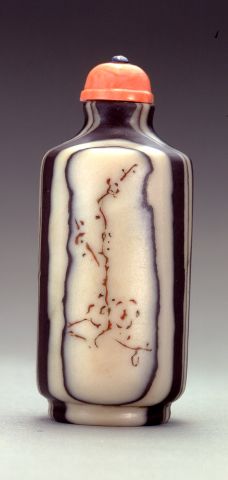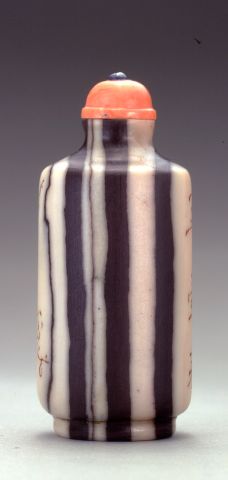


Bottle ID: 911
WHITE, DARK BROWN STRIPES, SCRIPT
Date: 1750-1880
Height: 60 mm
Baslat, , well hollowed, of cylindrical form with shoulders sloping to an everted mouth and with a deep footrim, with concentric stripes of cream and dark brown running vertically around the bottle, forming an irregular oval panel on which is incised a blossoming prunus branch, the opposite side with a similar panel with three characters.
Similar Examples:
Crane Collection no. 140
Provenance:
Asian Art Studio
Christie's, Hong Kong, April 25, 2004, lot 882
The J and J Collection
Hugh M. Moss Ltd.
Sotheby's, Honolulu, November 7, 1981, lot 168
Bob C. Stevens
Exhibited:
Poly Art Museum, Beijing, 2003
International Asian Art Fair, Seventh Regiment Armory, New York, 2003
National Museum of History, Taipei, 2002
Portland Museum of Art, Oregon, 2002
Nalples Museum of Art, Florida, 2001-2002
Percival David Foundation of Chinese Art, London, 1997
Museum fur Kunsthandwerk, Frankfurt, 1996-1997
Empress Place Museum, Singapore, 1994
Christie's, New York, 1993
Mikimoto Hall, Tokyo, 1978
Published:
100 Selected Chinese Snuff Bottles from the J and J Collection, back cover and no. 42
Moss, Hugh, Victor Graham and Ka Bo Tsang. The Art of the Chinese Snuff Bottle - The J & J Collection, 1993, Vol. I, p. 150, no. 83
JICSBS, Summer 1991, p. 6, fig. 4
JICSBS, Autumn 1989, front cover
Sotheby's World Guide to Antiques and Their Prices, 1986, p. 671, no. 2
JICSBS, December 1978, p. 43, fig. 265
Chinese Snuff Bottles and Dishes. Catalogue of an exhibition from the Collection of Bob C. Stevens, Mikimoto Hall, Tokyo, 1978, p. 94, no. 265
Stevens, Bob C. The Collector's Book of Snuff Bottles, 1976, pp. 172-173, no. 657
Described by Hugh Moss in The Art of the Chinese Snuff Bottle - The J & J Collection, Vol. I as the only snuff bottle known in this material. Bob Stevens calls this stone "Zebra Stone", but it is in fact a type of basalt. Stevens further states that Zebra Stone was only found in one unique deposit in Australia and was imported into China at some point during the nineteenth century.
< Back to full list
 English
English 中文
中文